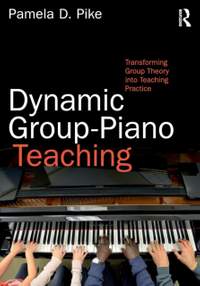Book
$183.50Printed on demand
Contents
- Acknowledgements
- List of Figures
- Preface
- Introduction
- Section 1 Background of Group-Piano & Working With Groups
- Chapter 1 Group-Piano 101
- Objectives
- Historical Overview of Group-Piano and Its Context Today
- Categories of Group-Piano Lessons
- Occasional Group Classes
- Regular Group Classes
- 3 Weeks of Private Lessons; Group Lesson Only During 4th Week
- 4 Weeks of Private Lessons; Group Lesson Also During 4th Week
- Private (or Partner) Lesson & Group Class Every Week
- A Note About Partner Lessons
- A Private Lessons and a Group Lesson on Alternating Weeks
- Occasional Group Camps
- Group-Piano Only and the Teaching Space
- Benefits of Group-Piano for Student and Teacher
- Considerations Regarding Group-Piano
- Special Skills Required of a Group-Piano Teacher
- Student Readiness for Group-Piano Lessons
- Teacher Readiness for Group-Piano Lessons
- A Final Note of Caution
- Pedagogy in Action (Questions to Answer)
- References for Chapter 1
- Chapter 2 Brief Overview of Learning Theories That Teachers Should Consider
- Objectives
- Introduction
- Learning Theories
- What is Learning?
- Behaviorism
- Psychosocial Development, Cognitive Development & Human Learning
- Other Theorists & Theories for Teachers to Consider and Explore
- Discussion & Implementation in the Piano Class
- Reflection on the Use of Learning & Developmental Theories in the Group-Piano Setting
- Two Sample Classes
- Pedagogy in Action
- References for Chapter 2
- Chapter 3 Group Theory and Group Dynamics in the Piano Class
- Objectives
- Two Vignettes of Group-Piano Students
- Vignette One: First-Year Group Piano
- Vignette Two: Beginning Seven-Year-Old Group Piano
- The Power of the Group
- Group Dynamics and Group Growth: Background & Relevance to Group-Piano
- Stages of Group Growth
- Forming
- Storming
- Norming & Performing
- Adjourning
- Discussions of the Stages of Group Growth and Cohesiveness
- Priming the Group for Success and Considerations for Group-Piano Instructors
- Pedagogy in Action
- Additional Reading & Exploration
- References for Chapter 3
- Chapter 4 Addressing Individual Learning Styles Within the Group-Piano Class
- Objectives
- Preferred Learning Modes
- Individual Personality Types & Learning Styles
- Myers-Briggs Type Indicator
- Kiersey & Golay Personality Types
- Kolb's Learning-Style Preferences
- Reinforcing Cognitive Strategies & Learning Styles in the Piano Lab
- Useful Cognitive Strategies
- Using Learning Theories & Kolb's Learning Styles in the Group-Piano Class
- Engaging Active Experimenters & Reflective Observers in Technical Exercises
- Engaging Thinkers & Feelers in Improvisation
- Conclusion
- Pedagogy in Action
- References for Chapter 4
- Section 2 Group-Piano Students: Adults
- Chapter 5 The Music Major: College-Level Group Piano
- Objectives
- Introduction
- Philosophy for Including Piano Proficiency in the Undergraduate Music Curriculum
- Suggested & Required Skills
- Placement Tests
- NASM Requirements & Recommendations
- Overview of Piano Skills Required of Music Majors
- Assessment
- Syllabus
- Purpose & Materials
- Piano Proficiency Exam
- After the Proficiency & Supplemental Resources
- College Text Overviews
- Alfred's Group Piano for Adults
- Piano for the Developing Musician
- Keyboard Musicianship
- Contemporary Class Piano
- Piano Lab
- Pedagogy in Action
- References for Chapter 5
- Chapter 6 The Non-Major: Adults Groups for College Credit
- Objectives
- The Non-Music Major
- Philosophy & Theory
- Assessment
- Individual Assessment
- Piano Placements
- College Texts for Non-Majors
- Piano 101
- Piano for Pleasure
- Keyboard Fundamentals
- Pedagogy in Action
- References for Chapter 6
- Chapter 7 Leisure Adults in the Independent Studio, Community Schools, and Other Locations
- Objectives
- Introduction
- Grouping Adults
- Andragogy
- Lifespan Development
- Characteristics of Adult Learners
- Common Characteristics of Adults & Considerations for Teachers
- Cognitive Changes Associated with Age
- Physical Changes Associated with Age
- Other Implications of Age on Piano Study: The Importance of Clarity
- Needs of the Leisure Student and the Curriculum
- Serious Music Study or RMM: Two Paths Toward Musical Development
- Considerations when Designing Curriculum and Choosing Materials
- Adult Leisure Text Review
- Adult Piano Adventures
- Adult Piano Method (Hal Leonard Student Library)
- Piano Fun for Adult Beginners & Piano Fun
- Play Piano Now!
- I Used to Play Piano
- Returning to the Piano
- Handbooks for Teachers of Adults
- Making Music at the Piano: Learning Strategies for Adult Students
- Recreational Music Making Handbook for Piano Teachers
- Pedagogy in Action
- References for Chapter 7
- Section 3 Group-Piano Students: Children
- Chapter 8 Overview of Group Music Programs for Children
- Objectives
- Introduction
- Historic Group Programs for Children - European Influences
- Dalcroze Eurythmics
- Applications to Group-Piano
- The Kodlay Method
- Applications to Group-Piano
- Orff-Schulwerk
- Applications to Group-Piano
- Asian Influences
- The Suzuki Method
- Applications to Group-Piano
- Yamaha Music Education Program
- Applications to Group-Piano
- North American Influences
- Kindermusik International
- Musikgarten
- Music for Young Children
- Pedagogy in Action
- References for Chapter 8
- Chapter 9 Group-Piano for Children in the Independent Studio & K-12 Schools
- Objectives
- Overview of Group-Piano for Children
- Philosophy & Theory of Teaching Children in Groups
- Typical Types of Group-Piano for Children & Curricular Considerations
- Methods & Materials for Children in Beginning Group-Piano
- Average-Age Beginning Methods
- Alfred's Basic Group Piano Course
- The Music Tree
- Other Methods That May Be Used
- Resources for Advancing Groups
- Ensemble Resources
- Alfred Basic Piano Library Ensemble Books
- Hal Leonard Student Piano Library Ensemble Books
- Ogilvy Music Ensembles
- Ensemble Music for Group Piano
- PianoTeams
- Games
- Teacher Books on Games
- Useful Books for Theory, Improvisation, Composition, & Music History
- General Resources for Teachers
- Theory
- Resources for Teachers
- Books for Students
- Improvisation
- Composition
- Books for Teachers
- Books for Students
- Music History & World Music
- Materials Designed for Group-Piano Camps
- Books Specifically for K-12 Piano Classes
- Pedagogy in Action
- References & Teacher Resources for Chapter 9
- Section 4 The Group-Piano Instructor
- Chapter 10 Advantages and Disadvantages of Group Teaching & Additional Thoughts on Assessment from the Instructor's Perspective
- Objectives
- Advantages of Group-Piano Teaching
- Disadvantages of Teaching Group-Piano
- Assessment
- Pedagogy in Action
- References for Chapter 10
- Chapter 11 Characteristics of Effective Group-Piano Teachers
- Objectives
- Effective Group Teachers
- Curriculum
- Lesson Planning & Realization
- Group Engagement
- Measurement of Individual Outcomes
- Student Motivation
- Conclusions
- Pedagogy in Action
- References & Resources for Chapter 11
- Chapter 12 Common Pitfalls of Beginning Group-Piano Instructors & How to Avoid These Mistakes
- Objectives
- Introduction
- Policy & Procedural Issues
- Lesson Scheduling & Length of Term
- Unclear or Unstated Expectations for Students and Families
- Curricular Issues
- Inappropriate Lessons & Materials
- Lack of Specific Long-Term Goals & Objectives
- Inadequate Reinforcement
- Teaching Difficulties, Issues, & Assessment Concerns
- Teaching Not Telling
- Pacing, Flexibility, & Wasted Time
- Too Few Group Activities & Little Serious Learning or Musicianship
- Classroom Management
- Individual & Group Assessment
- Final Thoughts & Ideas
- Pedagogy in Action
- References for Chapter 12
- Chapter 13 Establishing Trust Within the Group
- Objectives
- Introduction
- Teacher's Role
- Sample Student Activities
- Rehearsing Ensemble Repertoire
- Improvising Accompaniments
- Pedagogy in Action
- References for Chapter 13
- Chapter 14 Logistics of Teaching Group-Piano
- Objectives
- Scheduling
- Surveys
- Optimal Time of Day
- Marketing
- Space in the Studio - Considerations
- Ancillary Materials
- Books & Multiple Copies of Music
- Games & Manipulatives
- Pedagogy in Action
- References for Chapter 14
- Chapter 15 Technology for the Group-Piano Instructor
- Objectives
- Introduction
- Basic Technology
- Digital & Electronic Pianos
- Computers, Audio, & Visual Aids
- Additional Technology to Enhance the Learning Experience
- Keeping Up With Technological Change
- Pedagogy in Action
- References & Resources for Chapter 15
- Appendix A.1
- Appendix A.2
- Appendix A.3
- Appendix B
- Appendix C.1
- Appendix C.2
- Appendix C.3
- Appendix D.1
- Appendix D.2
- Appendix E.1
- Appendix E.2
- Appendix E.3
- Appendix E.4
- Appendix E.5
- References
- Index




